Patagonia 2018 Trip Report: The Best Big Cat Experience in the World? Probably.
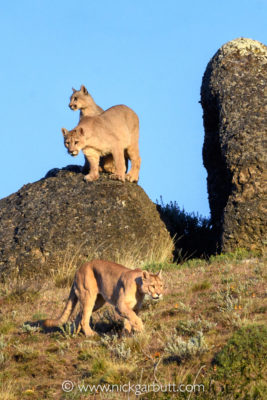
A female puma (foreground) with two of her near-adult cubs
My vote for the most exciting, spine tingling animal to see in the wild will always go to the tiger. The ultimate big cat. But I’d also be the first to admit that the circumstances and situation in many national parks in India can, at times, compromise the experience and enjoyment. There are often too many rules and regulations and you are very rarely alone.
On the other hand, perhaps the most exhilarating big cat to see in the wild is the snow leopard. The thrill of tracking down this ghost-like cat that is shrouded in mystery is further enhanced by the grandeur of its vast inhospitable mountain home in the Himalayas. But, unless you are very lucky, most sightings are at some distance away.
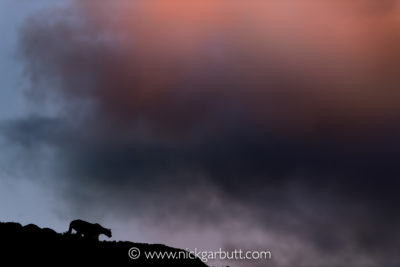
At first light a puma descends from the hills
However, if you are looking for the best ‘big cat experience’ on offer, then I’d plumb for pumas in Patagonia. There are a number of reasons for this. First, pumas themselves are beautiful and compelling (although admittedly that applies to all big cats, in fact all wild cats). Second, the surroundings are awe-inspiring: the rugged massif at the centre of Torres del Paine National Park has to be one of the most spectacular landscapes on Earth. And third, and perhaps most tellingly, the experience is so intimate: you see pumas almost as if you are a puma yourself.
Big cat watching just about anywhere else involves being in a hide or vehicle of some sort: a cocoon of human coziness, that separates you from the animal you are hoping to experience. In Patagonia it is different. You track pumas on foot. You are in their habitat. You are part of their environment. And when you find and watch one, you do so on equal terms. Imagine making eye contact and engaging the stare of a wild puma with no barriers in between. It is an exquisite, visceral thrill beyond compare.
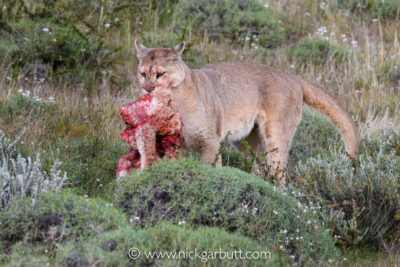
A female puma with a young guanaco (chulengo) kill
I spent a total of ten days in Torres del Paine in late November, early December 2018, and devoted a considerable amount of time and effort looking for pumas. With the help of an expert local guide, I spent many hours on hillsides, looking in likely spots and listening for the tell-tale alarm calls of guanacos (the pumas primary prey). This vocal reveal is a peculiar high pitched horse-like warbling whinny that wafts across the hillsides, but can be frustratingly difficult to pin point in the vast open spaces. It was early summer and the days were long (the equivalent of late May, early June in the northern hemisphere), so the regime was relentless with very early mornings and late nights as puma activity tends to be mainly around dawn and dusk. Early summer is also when the majority of guanaco calves are born. Something like 90% of all calves are born within a two week period (cf. wildebeest in East Africa) which means there is a glut of vulnerable food for the pumas, when hunting is relatively easy, but this period short lived.
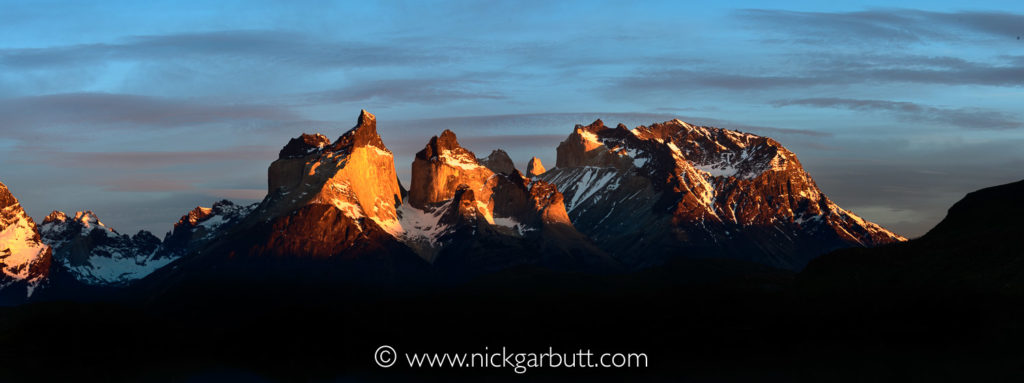
Dramatic light at sunrise on the Towers and Central Massif of Torres del Paine
The majority of my efforts were concentrated on private ranch land just outside the boundary of the national park. Within the park rules stipulate you have to stay on the trails and this of course limits flexibility and your efficacy when following the cats. On the ranch land there are no such restrictions, so it is easy to get away from all obvious vestiges of humanity and become immersed in the pumas world.
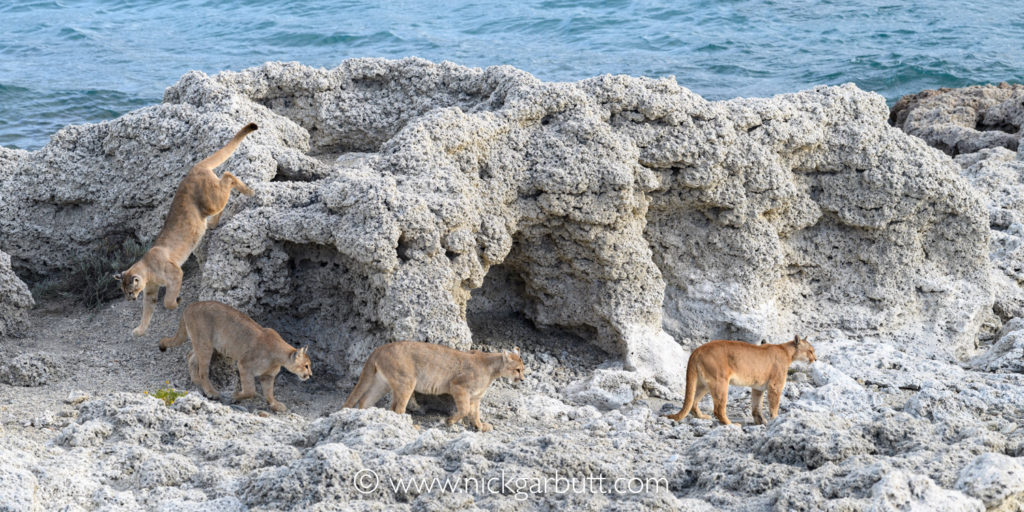
A female puma with three cubs on the shoreline of Lago Sarmiento
I spent a lot of time within the vicinity of the north shore of Lago Sarmiento, an other-worldly landscape whose rocky shores are dominated by thrombolites and stromatolites (ancient fossilised bacteria communities). These provide numerous nooks and crannies with shade that the pumas often use to rest in during the heat of the day. The area in which I concentrated much of my efforts was within the territory of a female puma with three adolescent cubs (around a year old). They would often spend the day sleeping somewhere along the rocky shore, then late in the day move away from the lake and climb into the nearby hills to hunt. Then just after first light the following morning they might be found returning to the lake shore area to sleep off the spoils of a successful plunder. Intercepting them on their evening trek up the hill or dawn return offered the best chance of a good sighting and meaningful photographic encounter.
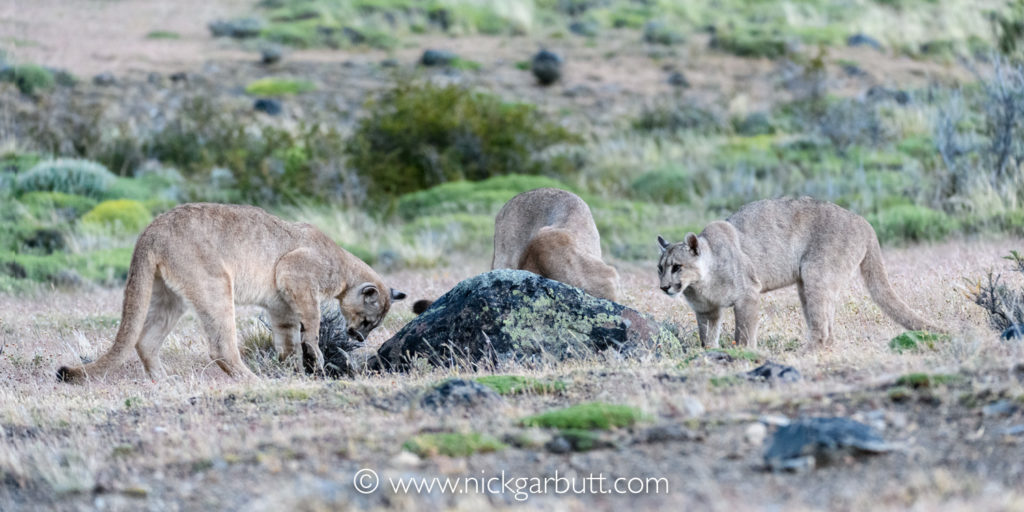
Three puma cubs digging around an armadillo burrow
At twelve months, the cubs were the same size as their mother (in fact the two male cubs were slightly larger), but they still needed their mother’s prowess to hunt and were often very playful, especially shortly after their daytime sleep. On one occasion, I watched the family spend over twenty minutes digging around a burrow of what I assumed to be an armadillo, the cubs in particular becoming utterly preoccupied. Ultimately, they were unsuccessful and lost interest, their mother calling them away as she ascended into the hills with more purpose.
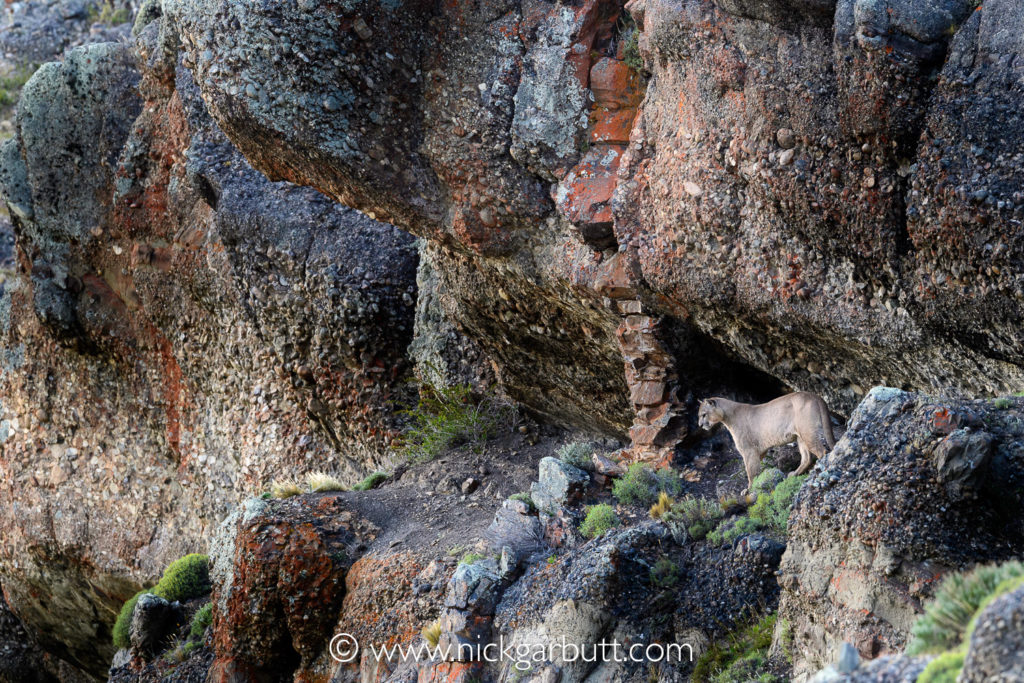
A huge male puma looking for his mate
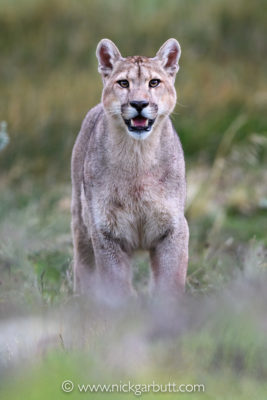
Eye to eye: the uncompromising stare of a young male puma
On another occasion well away from the lake and deep into the hills, my guide and I followed a huge male puma, who was clearly on the trail of a mate. We later found the subject of his desire, a female well-known to my guide. She was clearly on heat and it wasn't long before we caught up with male and female together, although she obviously was not quite ready to mate and kept refusing his advances.
Perhaps most memorable of all was a simple encounter with a young male. I'd watched him from a distance for a while as he slept next to a thicket. Then as he became active I regularly altered my position trying to second-guess his movements and get into the best place for a photo. What I really wanted was a shot of him walking towards me. Once I thought I'd sussed out his preferred direction, I committed and sat down on the hillside, making no attempt to conceal myself. He needed to know exactly where I was and it would then be his choice if he continued to walk toward me or decided to turn away. He chose the former.
As the puma walked nonchalantly in my direction he accidentally flushed a Patagonian skunk from the heath-like vegetation and half-heartedly scampered after it. The skunk quickly went to ground and escaped and shortly afterwards my nostrils were filled with their familiar and characteristic acrid burning rubber defense stench.
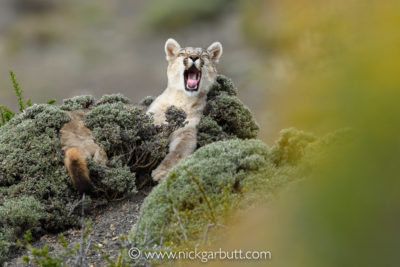
A young puma wakes from an afternoon sleep
The puma then continued, following a narrow trail through the thick tussock-like vegetation and within no time he was barely 20m away. He paused briefly to look at me, decided there was nothing of concern and walked on. As he passed by me, I met his uncompromising laser-like gaze and instantly felt a flush of adrenaline surge through me. It was magical. Without a second glance, he then continued on his way and in no time had melted away into the rocky terrain.
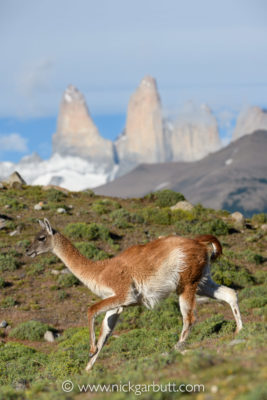
Adult guanaco with the famous 'towers' of Torres del Paine in the background
During my ten days tracking pumas, I actually saw more than 25 different individuals, including three different mothers with cubs. Around half of these were distant views of shy animals, but a good number were pumas that were tolerant of being watched and with appropriate, considerate, careful behaviour working with a responsible professional guide it was possible to gain a close-up window into the world of wild pumas and enjoy a big cat experience like no other.
Puma Photography Tours 2021
I will be running two photography tours to Torres del Paine in 2021, where the emphasis will very much be on the pumas (and the glorious landscapes). These tours will run in the winter months (July & August), when there are far fewer visitors to Torres del Paine, there is the possibility of photographing the cats in snowy environments and the shorter day length means the daily schedules concentrating around dawn and dusk are not as extreme as they are during the summer months.
Provisional names are now being taken for these tours. For further information please - click here.
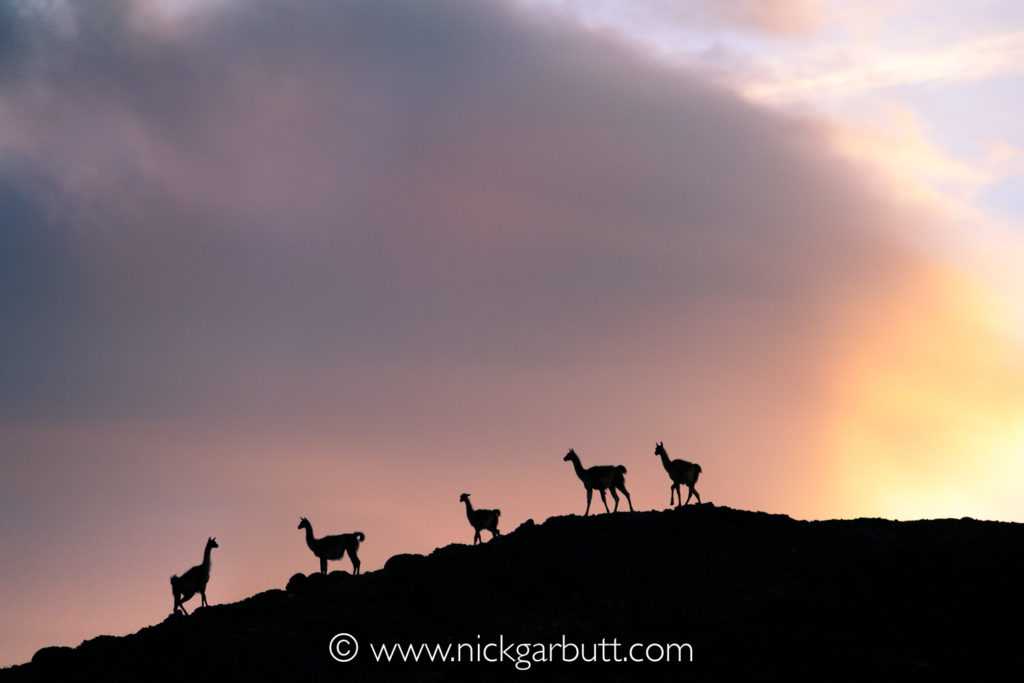
Adult guanacos in silhouette at sunset
